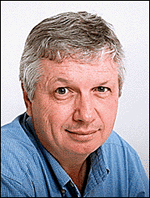


![]()
Talk Story
Roundabouts are
even dizzier idea
than traffic camerasTHE traffic cameras enforcing speed limits from roadside "Tali-vans," as Star-Bulletin columnist Charlie Memminger has dubbed them, aren't the only unpopular traffic trend in use in the wider world.
From Clearwater, Fla., comes word of another experiment that backfired: the roundabout.
We're not talking about a little, landscaped traffic circle like the ones the city plopped down in Makiki and Salt Lake to slow things down in high-density residential areas. Nope, we're talking about a big, landscaped traffic circle designed to eliminate stoplights and delays on traffic-choked roads.
Two years ago, Clearwater spent $8 million on a new roundabout to replace what was described as "a dangerous tangle of streets and intersections often choked with beach-bound traffic."
It's at a busy spot. Designed for 32,000 cars a day, the Clearwater roundabout handles more than 50,000 cars on busy beach weekends.
According to the Wall Street Journal, the outcome has been more than 500 accidents -- an average of almost five a week.
The owner of a local body and fender shop told the Journal the roundabout has been good for business, despite the fact that one of his tow trucks had an accident there.
Besides predictable confusion over which drivers have the right of way -- those getting on or those getting off -- cities have encountered other problems; for instance, drivers who turn left against the flow of traffic when they want off at the first side street.
The Clearwater roundabout offered an additional challenge. The fountain that graced its island also got in the way of seeing other cars and doused windshields when the winds picked up. It's been turned off.
ROUNDABOUTS are commonplace in Great Britain and New England, where road networks were established long before the automobile came on the scene. Still, they're a driving challenge.
The official British Highway Code's instructions for negotiating one runs to 540 words. It includes helpful tips such as: "In all cases watch out for and give plenty of room to pedestrians who may be crossing the approach and exit roads; traffic crossing in front of you on the roundabout, especially vehicles intending to leave by the next exit; traffic which may be straddling lanes or positioned incorrectly; motorcyclists; cyclists and horse riders who may stay in the left-hand lane and signal right if they intend to continue round the roundabout; long vehicles (including those towing trailers) which might have to take a different course approaching or on the roundabout because of their length. Watch out for their signals."
Got that?
Nine roundabouts have been built in the Orem and Provo, Utah, area, where this helpful advice appeared in the local paper:
"An often overlooked courtesy is to use your turn signal right before exiting to indicate which turn you are taking. Remember to watch for pedestrians and bicyclists, and don't drive straight through the middle island."
Trees, fountains and landscaping usually make driving straight through an unattractive option.
Traffic engineers say roundabouts differ from rotaries, which typically have large central islands at least 300 feet in diameter. Modern roundabouts are much smaller, they say, with islands measuring 5 to 120 feet in diameter.
Cars are supposed to go slower in a roundabout, about 10 to 25 miles per hour compared to 20 to 40 miles per hour on the old-fashioned rotary. Despite rotaries' being larger and having more room to merge, high speed made them notoriously dangerous.
Urban legend has it that the designer of an infamous rotary in Long Beach, Calif., was killed driving on it.
SUPPORTERS of roundabouts insist that they improve traffic flow and reduce the number and severity of accidents. As one engineering firm put it: "Accidents that do occur at roundabouts are generally low-speed rear-end or merge crashes, rather than high-speed angle collisions for conventional intersections."
However, supporters admit the numbers of accidents increase at the outset, while drivers are becoming acclimated to the dizziness.
In 1999, the city of Claremont, Calif., built a roundabout it hoped would improve traffic flow and attract more pedestrian shoppers. Local residents were skeptical, so the city agreed to a six-month trial.
According to the Los Angeles Times, a survey showed 63 percent of Claremont residents opposed the roundabout because it was confusing and dangerous.
In April 2000, less than eight months after it was built, the bewildering Claremont roundabout was ripped out.
Perhaps our Tali-vans are headed down the same road.
John Flanagan is the Star-Bulletin's contributing editor.
He can be reached at: jflanagan@starbulletin.com.